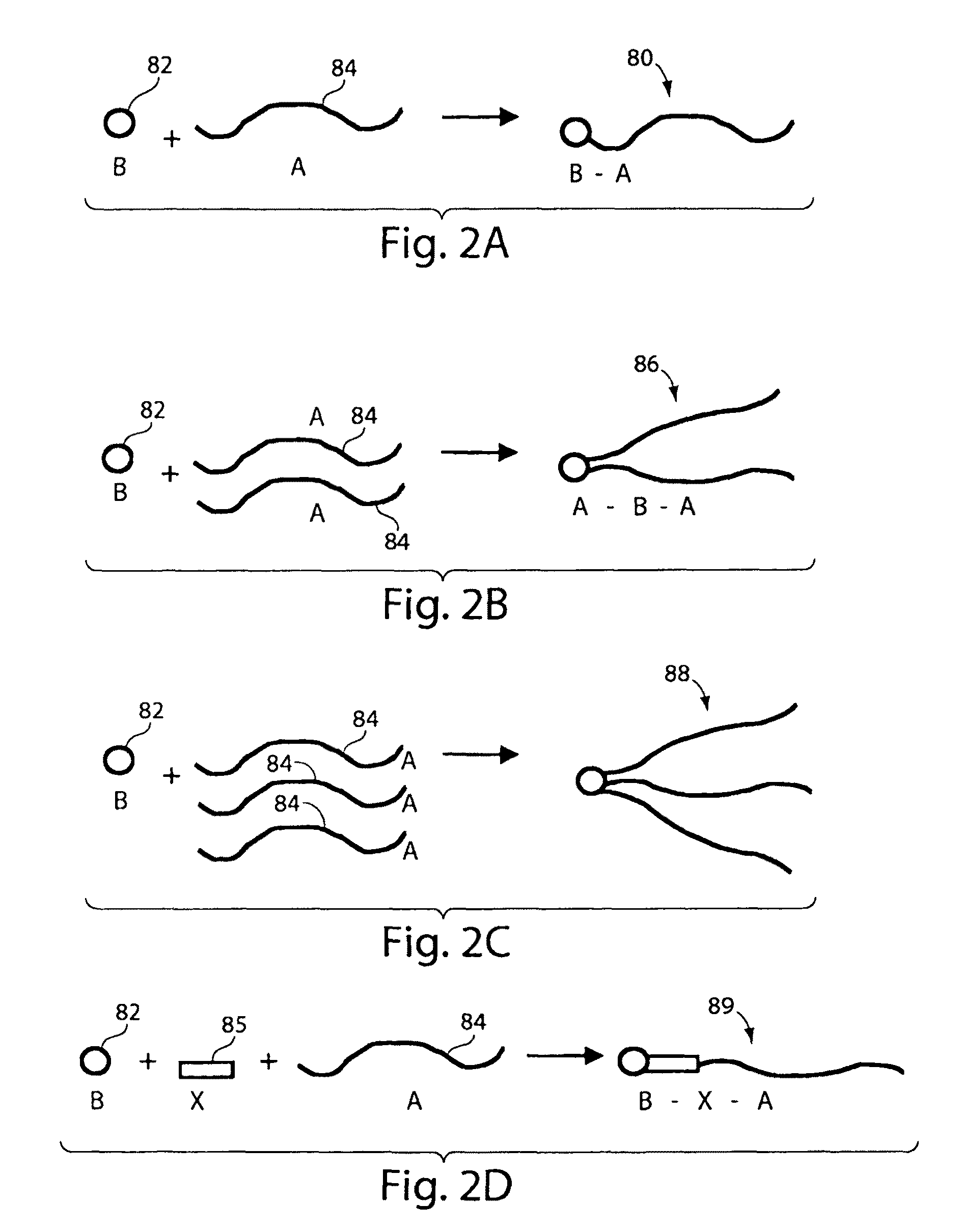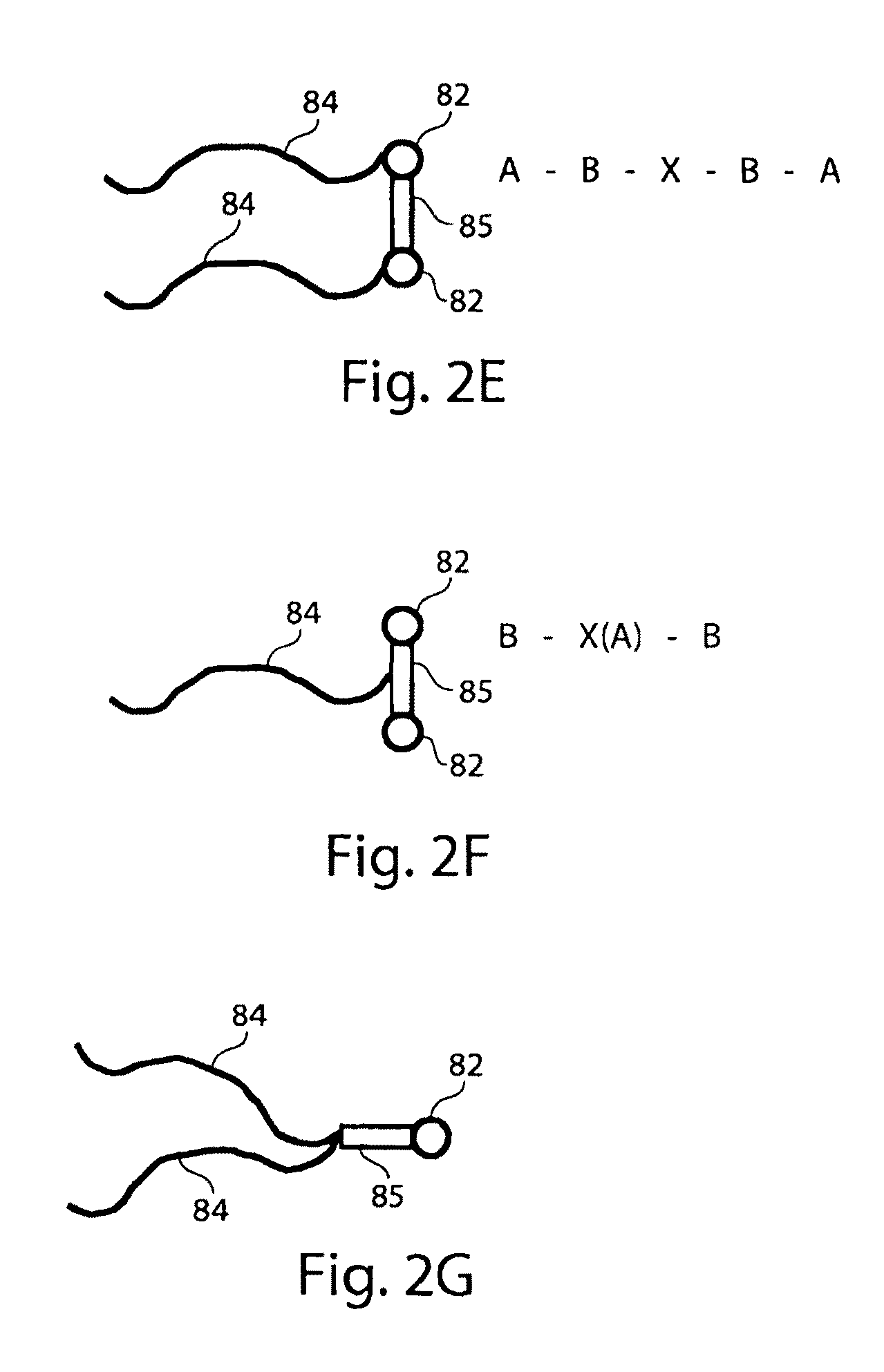Fluorocarbon emulsion stabilizing surfactants
a technology of surfactants and fluorocarbon emulsions, applied in the field of surfactants, can solve the problems of not having desirable physical characteristics or often not having surfactants availabl
- Summary
- Abstract
- Description
- Claims
- Application Information
AI Technical Summary
Benefits of technology
Problems solved by technology
Method used
Image
Examples
example 1
[0160]The following is an example of a procedure for forming an amide bond between a headgroup and a fluorophilic component of a surfactant:
Chemicals:
[0161]PEG-diamine (Mw=400 from Tomah)[0162]KRYTOX® methylester (KRYTOX®-COOMe) (Mw=1900)[0163]THF (dry) or CH2Cl2 (dry)[0164]HFE 7100 (added molecular sieve to ensure dryness)[0165]possibly molecular sieves for drying[0166]for purification (removal of excess KRYTOX®-COOMe): Aminomethylstyrene-crosslinked
Materials:[0167]stirrer[0168]distillation setup, or a rotavap[0169]flasks (100 ml), stirrers and standard equipment like glass syringes (Pyrex), funnel, etc.
Procedure:[0170]1.) Dissolve 0.5 g of PEG-diamine (400 g / mol) (Tomah) in 15 ml THF. Use a 50 ml or 100 ml flask.[0171]2.) Dissolve 4.69 g KRYTOX®methylester (1,900 g / mol, corresponds to 10% excess considering the presence of 25% PEG-monoamine in the Tomah product) in 10 ml HFE 7100.[0172]3.) Mix the solutions from 1.) and 2.) and stir at room temperature overnight (or up to several ...
example 2
[0179]This example illustrates the following procedure for forming an ester bond between a headgroup and a fluorophilic component of a surfactant:
Chemicals:
[0180]PEG-dicarboxylic acid (Mw=600, from Sigma-Aldrich)[0181]KRYTOX® Alcohol (Mw=1900)[0182]SOCl2 [0183]4-Polyvinylpyridine (2% cross-linked, from Sigma-Aldrich)[0184]DMF (dry, as a catalyst, however: only small amount)[0185]CH2Cl2 (best if dry—Sure Seal bottle or DrySolv)[0186]THF (dry)[0187]HFE 7100[0188]possibly molecular sieves for drying
Materials:[0189]hot plate stirrer with external temperature probe[0190]oil bath[0191]reflux setup with balloon[0192]glass filter / column with silica / glass wool[0193]distillation setup—or ideally a rotavap, balance[0194]flasks (100 ml), stirrers and standard equipment like glass syringes (Pyrex), funnel, etc.
Procedure:[0195]1) Dissolve 1 g dicarboxy-PEG in 10 ml methylenechloride. Helpful: Use a 100 ml flask.[0196]2) Add 0.8 g (0.6 ml) thionylchloride (corresponds to 2-fold excess), while cool...
example 3
[0207]For testing emulsion stabilities of the emulsions shown in Table 1, the emulsions were formulated containing Fluorinert Electronic Liquid FC 40 fluorocarbon oil (available from 3M) with 1.6 wt % of the respective fluorosurfactant. FC 40 is a perfluoro compound with primarily compounds with 12 carbons, with the hydrogen replace by F. 10% v / v with respect to the fluorocarbon phase and the alcohol was added. Emulsification was carried out by first turning over the vessel, then shaking it by hand for 15 s and finally shaking it vigorously by hitting the edge of a table for an additional 15 s and for an additional minute, if emulsification was insufficient.
PUM
| Property | Measurement | Unit |
|---|---|---|
| diameter | aaaaa | aaaaa |
| diameter | aaaaa | aaaaa |
| diameter | aaaaa | aaaaa |
Abstract
Description
Claims
Application Information
 Login to View More
Login to View More - R&D
- Intellectual Property
- Life Sciences
- Materials
- Tech Scout
- Unparalleled Data Quality
- Higher Quality Content
- 60% Fewer Hallucinations
Browse by: Latest US Patents, China's latest patents, Technical Efficacy Thesaurus, Application Domain, Technology Topic, Popular Technical Reports.
© 2025 PatSnap. All rights reserved.Legal|Privacy policy|Modern Slavery Act Transparency Statement|Sitemap|About US| Contact US: help@patsnap.com



